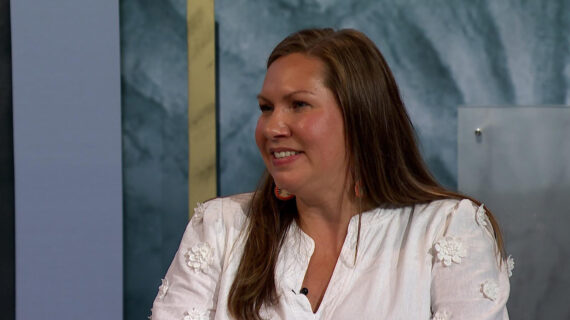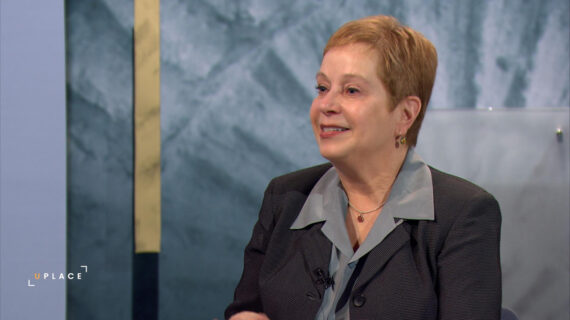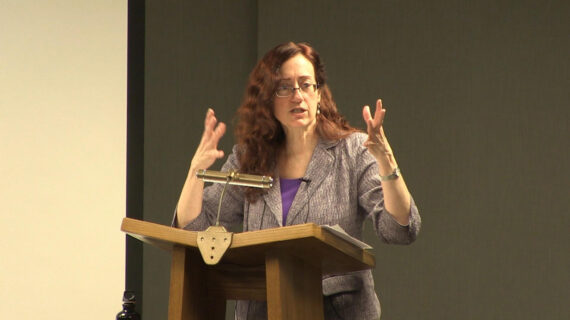– Tonight’s speaker is Kevin McKinley, who many of you know, not only as the founder of his own financial advice firm but also from On Your Money on Wisconsin Public Radio. So with that, I’ll turn it over to Kevin.
(audience clapping)
– Thank you Scott, thank you very much. I bought my first stock when I was 14 years old. When I was 15, I went back into an investment firm and I said I want to be a stockbroker, and I thought that that was a normal thing to do. Now that I’m old and smart I realized that that’s not a normal thing to do, but I did that. I started an investment club while I was in high school. I started working for that financial services firm when I was 17. I went to the University of Wisconsin. I had graduated when 1988 with a degree in economics and history, I barely graduated, but I did graduate, and I started the next day working for that same financial services firm as a financial advisor. I did that for 20 years, and then about 10 years ago, I left to go out on my own, starting my own firm, McKinley Money, which is a registered investment advisor. And, one of the interesting things about this is I got into this business because I love stocks and I love looking at investing and I love analyzing all the different factors, like earnings per share and cash flow and all that. And I applaud people who want to do that, like you, who like to look at balance sheets, to look at that. But one of the issues that I have with that, is I found after serving mostly middle-class millionaires and people who are financially independent, and who are either retiring or retired, that a lot of that time and energy spent in analyzing those things, does absolutely nothing, to ensure your financial security, because it’s all based on things that have happened in the past which really don’t affect us, or may happen in the future, which to be fair, despite all the ratios and prognosticators, and people who try to tell you what is going to happen in the future, nobody knows. I don’t know, you don’t know, and they don’t know. You can watch CNBC all day, someone very credible will come on and tell you why they think XYZ is going to happen and then someone just as credible will come on right afterwards and say why XYZ isn’t going to happen, and they may both be right, it depends on the time of it. So what I want to do is talk a little bit today about some of these things that you can’t control, and then some of the things that you can control to help you increase the amount of return that you get on your investments while not taking on any extra risk.
So this is what you can’t know and can’t control, market performance. Lot of times I’ll be in a meeting, I was in a meeting in my office here in Madison this afternoon, with a really great client for two hours. I had no idea what the stock market was doing during those two hours, and I definitely couldn’t control it. I also can’t control the asset class performance. We don’t know tomorrow if bonds will beat stocks or if real estate will beat both bonds and stocks, or if cash will outperform all those other three classes, just by not losing any money whatsoever. We also don’t know how the manager will do. We could be on the right horse in the terms of let’s say, emerging market stocks, but we could pick the wrong jockey, a manager that picked all the wrong emerging market stocks, even while the other kinds of emerging market companies were doing well. And then finally we have personal future issues. If you’ve had your money invested in Apple Computer 25 years ago, and you had a couple thousand dollars in there, but she had to pull that out because he had to pay for a car repair and it was the only $2,000 that you had. You cost yourself hundreds and hundreds of thousands of dollars in future appreciation, and you have no control over that. I highly recommend you get a car fixed and sell your stock if you have to do it, but we don’t know what our individual futures will bring. And as part of my job, I become almost part therapist to my clients because we have to deal with all these different life issues. I deal with marriage and divorce and birth and death, and you know this, you seem like most of the people in this room have lived a long enough time to realize things can happen good and bad out of the blue, and they can really change the way that you’ve planned out this 25- or 30-year performance. In the long run when it comes to investing, we’re all dead. All right? And that’s one of the few things we have no control over whatsoever. And so I’m going to talk with you about trying to plan for the short-term, try to plan for the long-term at the same time. We’re going to talk about the factors that you can control and you can know, and then we’re going to talk about how to figure out where you are at financially, not only if you’re saving for retirement, but also to figure out how much you can spend in retirement, regardless of your situation, regardless of how much money you have, and regardless of what the market performance does, et cetera. So here’s what you can know and what you can control, taxes. Scott mentioned that you have someone coming in to talk about the new tax law. I mentioned, I have no idea, I still haven’t checked to be honest with you, what the Dow Jones Industrial Average did today, and I don’t know what it’s going to do at eight thirty Central Standard Time tomorrow morning when it opens up. But I do know what the tax code is going to say for 2018, and I have a pretty good idea of what it’s going to say for 2019. So I would rather predicate your long-term financial success on trying to reduce and know your taxes. The second thing is, is your investment expenses. How many of you use low-cost index funds like Vanguard?
Okay, I’m a huge fan of that. It’s not because Vanguard is a great company, I do happen to think it’s a great company. I know it very well and a lot of my clients have those funds. The reason that I liked those particular funds, is not because I think they’re going to be great funds in the future, it’s because I can know the investment expenses, the internal expenses of those particular mutual funds. And I can judge right away, and we’re going to make a very clear demonstration on why you need to focus on that more so than trying to guess which one of the funds is going to outperform in the future. And then finally, interest costs. One of the things, I’m going to date myself for this video performance here, but I’m going to say that one of the big issues that people are going to face in the coming months and years, is money that they have in bond mutual funds that they feel is very safe, and very secure, and very predictable, and they’re going to find out that that’s not necessarily the case. So we’re going to talk about that, and how to solve that in a second here. Let’s get on with the taxes first and how to cut your taxes. I am a big believer in smoothing your taxable income. And by smoothing, I mean trying to stay under the 12% federal income tax bracket at every single opportunity that you can. We’re going to talk about some strategies here that you can use year in, year out, no matter where you’re at in life, but then also before you’re working and after you’re working. But in the 12% federal taxable bracket, that’s the old 15% bracket, before the tax law change this year. And it’s what’s delineated on line 43 of your 1040 and I think for 2018 it’s like $77,650 for married couples filing jointly, something like that, and half that for single filers. But the way it works out, is if you can keep your gross taxable income under $100,000 for married couples filing jointly, and $50,000 for single filers, you’re probably going to keep yourself from going up and over the top of that 12% federal income tax bracket. And the big reason why I’m so concerned about this, is because first of all, in Wisconsin, you can live a pretty good life on these incomes. And second of all, if you do go over that 12% bracket, the next one up is 22%, so anything you go over that, you got an extra 10% kicker on top of that, that the federal government will take out of your taxes every single year.
And then finally, we’re going to talk about before and after retirement, because it’s relatively simple to do it before you retire. It’s actually much easier to do it after you’re retire. Because when you’re retired, you have much more control over your income. When you pull money out of your IRAs, and when you choose to initiate Social Security, and in some cases when you choose to sell particular assets to fund your retirement. These are tax-saving strategies that you can use year in, year out, regardless of if you’re working or after retiring. Shelter interest, when you earn interest on anything like a bond, a normal bond, not a tax-free bond, but a taxable bond, savings account, checking account, certificate of deposit, what have you, that’s piled on top of your taxable income, and it will be taxed at the highest rate of all of your income. So if it’s possible, you want to put those types of investments in your IRAs, 403
(b)
s, 401
(k)
s, Roth IRAs, and if you have annuities, those as well too, because at least that will be sheltered from taxation.
Some of the funds that I like to see people to leave outside of that are your stock mutual funds, and the reason being is that when you have stock mutual funds, you can realize losses that you have, and use the losses to offset capital gains, and you can also use it to offset future income. If you take a $10,000 of loss in a stock fund that’s outside of your retirement accounts, you can use $10,000 against any realized capital gains that year, but you can also carry it forward $3,000 per year against ordinary income. So if you have any losses in these types of accounts and they’re outside of your tax-deferred accounts, make sure every single year that you take those losses and then if you wait 30 days, you can go back in and you can buy that same asset, so then you can establish that higher cost basis again as well. And then finally realize 0% capital gains. If you can keep your overall income in the 12% federal income tax bracket, all of your long-term capital gains won’t be taxed. So if you look at some of these positions, you say, jeez, it’s been a good year, we have some capital gains that I haven’t sold yet, in funds that are outside of retirement accounts, take those gains if you can stay in that 0% bracket. Because again, you don’t pay any capital gains taxes on it, and then you wait 30 days and you can buy it back again, and because you bought it back again, you’ve established a new higher cost basis on that particular asset going forward.
And then finally, donate wisely. Many of you I’m sure are very charitable and you give to your religious organizations, hospitals, your university, Wisconsin Public Radio, and when you do, normally you can deduct that, if it exceeds the standard deduction, it makes sense. Because the standard deduction was raised with the 2018 tax law changes up to $12,000 for single filers and $24,000 for married couples filing jointly. It’s going to be harder and harder to make those charitable deductions count as part of an itemized deduction. So what you want to do, is you generally want to donate during very good years when you have a lot of itemized deductions that can exceed the standard amount, and then don’t donate anything during those down years when you maybe don’t have as many deductions. One of the smartest things you can do if you can afford to do it, is slide money into a donor-advised fund. How many of you are familiar with those? Okay, they’re really great tools, I love those, like I said, I’ve done this for 30 years now. It’s very funny when I have clients, we’ve set those up for people, we’re giving money away. I mean, once you put the money in the donor-advice fund, it doesn’t go directly to the charity, but it’s gone from our use forever. I had never had an investment where more people have said to me, gosh that was really cool Kevin, I love the way that work. That was neat the way we put the money in there, I see that tax bracket, it’s been really fantastic. So in a year in which you’ve had a lot of capital gains, a lot of income, put money into the donor-advice fund, and then in the future when you’re in lower tax brackets, then that’s when you peel the money out to the charities, because you don’t get a break on it at that time when you put the money in. Finally have a home equity line of credit, how many of you have established a home equity line of credit? Yeah, there’s one thing I’d recommend you do tomorrow morning based on this presentation. Call your local lender, go out and set up a home equity line of credit. And when that lender asks what I needed for, say ’cause this guy at the library told me I should get it. And then when they say, well how much should I get it for? Say, how much will you give me? And what you’ll find is they may charge you a little bit to set it up, like $500, maybe a $1,000, if you also need to get an appraisal. Sometimes some credit unions and other banks, have a sale, where they say, we’ll set up a home equity line of credit for you with no charges whatsoever. But even if they do charge you for it, take it, and if they do charge you to keep it open. If it’s $50 a year or something like that, pay that, because it’s really cheap access to your home equity that you can get out whenever you want without having to go through the application process. Because by definition, if you need money, the banks are unlikely to lend it to you. And if you have the home equity line of credit already established, you can tap it, you only have to pay interest on what you borrow. And generally paying a little bit of interest on this home equity line of credit is better than paying a bunch of penalties and taxes, especially if you’re under 59 and a half and you’re pulling it out of an IRA or 401
(k)
or something. Where we see this a lot with our retired clients, is they get to November and we’ve tried to manage their income to keep it below the 12% federal income tax bracket, and all of a sudden something happens, there’s an uncovered medical expense, a piece of property goes up for sale they really want to get it today. Stop me if you’ve ever heard this before, but their young adult children need some money right now. Yeah, exactly, and they say, where do I get this money from? Because if I pull it out of the IRA, I’ll go up through that top of that 12% federal income tax bracket, and I said, well, let’s take it from the home equity line of credit. We’ll pay a couple months’ worth of interest on whatever we borrow and then next year, we can take money out of the different sources more wisely from a tax standpoint as well. And a little bit of interest is much better to pay than a lot of taxes. These are tax strategies you can use while you’re working. First of all, maximize your pre-tax savings. A lot of people who are, in my opinion, too smart by half, who do a lot of analysis on taxes and investments, think that it’s better off to save money into Roth 401
(k)
s and Roth 403
(b)
s while they’re working because they want it to be tax-free in retirement. And I’m here to tell you, I’ve dealt with hundreds of people in retirement, almost every one of them is in a lower tax bracket in retirement than they were when they were working. Therefore, it makes better sense in almost every case to defer taxes while you’re working, by saving money into 401
(k)
s, 403
(b)
s,457s, IRAs, and then pay taxes on it in retirement, because you’re going to be in a lower tax bracket then, than you are right now. So maximize your pre-tax savings and then put any extra money that you have into a Roth Ira. What I’d like to see you to do on the pre-tax savings, is least get the employer match, try to get your taxable income below the 12% federal income tax level, and then finally maximize the 401
(k)
, 403
(b)
, which is 18,000 and 24,000 or whatever for people over 50 years old, and then if you say, all right, I can’t afford to put any more in, or I’ve reached all my limits, then switch your savings to a Roth IRA. You do not get a tax break on the Roth IRA of course, but the future earnings are sheltered from taxation, and a lot of people don’t know this, but when you put money into a Roth IRA, you can pull the contributions back out the next day, if you want, with no taxes or penalties whatsoever, for any reason, so if you put $5,000 into a Roth IRA today, tomorrow you can pull the $5,000 back out. The good people at the IRS let us designate our withdrawals as contributions first until we’ve eaten up all of the earnings on it. And when we pull the contribution we get to do whatever we want. So that should kind of be a rainy-day fund for workers. If you have $5,000 in savings slide it into your Roth IRA if you qualify for it, because if you need it, you can always pull the contributions back out whenever you want with no taxes, no penalties whatsoever.
529 plans, we get a lot of questions from people who say, I want to save money for college for my kids, or my grandchildren, nieces, nephews or whatever. I’m a big believer in 529 plans. They’re just not right for everybody, and they definitely should not be prioritized over paying off high-interest debt like credit cards or saving for retirement. Because can you borrow money to go to college? Yes, can you borrow money to retire? No, you cannot, so it’s better off to prioritize retirement and make college savings a secondary goal. It’s kind of like when I have three children, I think three children, yeah, three. And when we fly, when they were little, the flight attendant would always give us the instructions beforehand about exits are vaguely designated to this way, and this way, which I didn’t even know where she was pointing. And also if the oxygen mask drops down, put yours on yourself, then put it on the kid next to you. That’s the way you should prioritize your long-term savings, as well. Take care of yourself first by saving for your own retirement, and then take care of the kid by trying to save extra money for college in the 529 plan. If you can afford to do it, the optimal amount, in my opinion, to save for college is the $3,100 give or take in the Edvest account that gives you a state income tax break per beneficiary. So if you have three children, three grandchildren, whatever, you can save $3,100 for each kid and the state of Wisconsin will reduce your taxable income, at the state level by a total of $9,300. So the $3,100 deposit saves you about 150 bucks each on your state income taxes. And you still keep total control over the money, any future earnings are sheltered from taxation, and if it’s pulled out for qualified higher education expenses, no taxes whatsoever. So unless you’re independently wealthy and you’ve got all things figured out, I prefer that’s the limit for 529 plans for contributions for children and for grandchildren. And then finally we talked a little bit about peak and valley deductions. When you have things like property taxes, donations, anything that can exceed the standard itemized or standard deduction, do that in one year, and then in the next year, don’t make any donations, try to pay as little in property taxes as you legally can. I found that you can’t just call up the local treasurer and say, hey, this is a year I’m not going to itemize, so I’m not going to pay my property taxes. They’re not big fans of that strategy. So, but you can sometimes pay three half year’s of property taxes in one year, and then one-half year in the next calendar year so that you can get a much bigger itemized deduction on that.
Now this is some tax saving strategies after retirement. I think we have a couple of retired people in the room here. Okay, good, all right. This is the big one. First of all, if you haven’t already taken your Social Security or your pension, try to delay it, if you possibly can. And the reason being is not because some of the things you hear about what people say, oh well, always wait to take Social Security because you always get more money. That’s true, except then you have to live long enough to make up for those missed, deferred payments. There’s a minimum, you have to live to 80. And the median age at which people take Social Security is actually 63 for retirement, so half have already taken it after their first year of eligibility for it too.
Several clients who’ve come to me and say, when should I take Social Security? And I said, it’s a really easy question to answer, all you have to do is tell me when you’re going to die and I will tell you when to take Social Security. And since they don’t know that, it involves more about strategizing for tax purposes here. But if you delay taking your Social Security, or your pension, and you can hopefully have some savings outside of retirement accounts that you can live off of, you can then convert IRAs to Roth IRAs, again, up to that 12% federal income tax bracket. So you, if you have $50,000 in your checking or savings account for an example and you need $50,000 to live off of that year, live off that $50,000, and convert whatever you can from IRAs to Roth IRAs, and then wait to take Social Security. Because Social Security is a very interesting tax animal. Social Security’s technically tax-free when you receive it. And there’s a formula that says add into all of your other income plus half your Social Security and that determines if you actually pay taxes on your Social Security. Well, Roth IRA distributions are the only source of income that is not included in that formula. So under today’s laws, you can take a million dollars out of your Roth IRA while you’re collecting Social Security, and it won’t make your Social Security more taxable. So we want to convert IRAs to Roth IRAs for as long as you can stand it, and then after that, then take your Social Security. And then finally, if you can still do it after Social Security, convert IRA’s to Roth IRAs so that again, you stay under the 12% federal income tax bracket. And what you’ll find is if you can get through this strategy, by the time you’re 70 and a half, you will have a bunch of money coming from Social Security, you’ll have a bunch of it in Roth IRAs, you’ll still have some of it in your taxable IRAs, but your required minimum distributions at seven and a half had been reduced by so much that you will pay much less in taxes on your Social Security income, and then you’ll pay no taxes on your Roth IRAs as well, okay.
Now here’s another talk about lowering your investment expenses for your mutual funds in particular. How many of you are familiar with internal expenses for mutual funds? And you know how that works? These are generally posted, although you have to really dig into the prospectuses to find out exactly what they are, but I’m happy with the figures that I get from Morningstar, et cetera, or the fund companies themselves for cursory comparison for it. And specifically mutual funds that have a high expense, are often actively managed. One of the things that I found is there’s no guarantee that paying more in mutual fund expenses, will give you better performance in the future. It’s happened in the past, but there’s no way that any of these mutual fund companies can say, well, if you pay us a 1% annual fee, we will do better for you, than if you pay a half a percent fee. And that half a percent can make a huge difference. Let’s say you have to stock mutual funds, and fund A has a half a percent internal expense, fund B has a 1% expense and you’re going to save $5,000 a year over 40 years, and both of those funds are going to grow, so seven and a half percent in return, before the expenses. Okay, while the one that has just a half a percent expense, you’ll end up with $1,068,000 in that. But the other one that actually charged you 1% versus the half percent, you’ll end up with $935,000 because of that half percent extra erosion across the top of it. And so it’s very important to pay attention to those expenses because even half a percent can mean almost $140,000 difference on a relatively small deposit over a very long period of time. Second thing, we talked a little bit about bonds funds versus bonds. Bond funds have expenses within them, and a lot of times when interest rates are very low like they are right now, the expense ratio can be almost as high as the actual yield of the portfolio. There’s some bond funds out there that charge 1% and they only pay one and a half to 2% in the terms you yield for it. So 1% doesn’t sound like a lot, except that’s about two thirds of your investment yield that you’re taking from that. And bonds in and of themselves have absolutely no internal expenses, once you buy the bond and you hold it to maturity, there’s no extra expenses on top of that. And then plus we talked a little bit about the risks of going into bond funds, which again, I really like those in most circumstances. But in a period of rising interest rates, which we’re just starting to go into right now, and you may continue going in, bond funds can be very damaging because they have a tremendous amount of downside. You can lose 30 or 40% in a bond fund if the securities become– if investors become concerned that they’re not going to get paid off on their bond funds, or if interest rates rise significantly. Up until about the end of April, the Morningstar category for long-term government bonds, they lost about 5% on average just this year. And that’s just with interest rates just ticking up a little bit right here. Now the problem with that is that those bond funds in general probably only paid about two and a half percent per year in interest. So those people who bought on January 1st and held on through the end of April, they now have to have not only everything stay flat hopefully, but they have to wait two years just to get back to even if they make two and a half percent a year to make up for that 5% loss that we’ve already had. And again, interest rates have done absolutely nothing compared to what they could do. How many of you bought a house in the late 1980s or early 1990s? Raise your hand, all right. What was your mortgage rate when you when you paid that?
–
[Audience member]
8%.
– 8%, and you were happy to get it, weren’t you? Yeah, I can’t believe there are so great they’re so nice to lend me money at eight, or nine or 10, or 11, or 12, or 13%. I don’t think we’re going back to that environment again, as matter of fact, I hope we don’t because I don’t think the economy can handle those kinds of interest rates again. But if we go to four, or five, or 6%, you’re going to see a big decline in bond funds, and bond funds are going to be made worse than actual bonds, because at least with an actual bond, I know if I hold it to maturity and the bond payer stays in business, I’m going to get my interest and I’m going to get my money back. With a bond fund I have no idea where my money is on that particular day. I have no idea what I’m going to get back, when I’m going to get it back. And I don’t know what interest rate I’m going to get in between now and then. And then of course, most investors now are not familiar with existing in a rising interest rate environment. Interest rates haven’t really risen for 30 years. They’ve gone down from that 19% rate in the mid to late 80s down to basically nothing a few years ago. And they just started to come up. And I’m very concerned about what a lot of people who have bond mutual funds, how they’ll react. If you say, oh, it’s okay Kevin, I’m a long-term investor. I’m going to stick with these bond funds, that could still hurt you because as the bond fund manager gets redemptions from other people who don’t have your intestinal fortitude, he or she has to sell bonds at discounted prices, and that can add fuel to the fire for it. More people see the net asset value is dropping and dropping and then they say, gosh, what am I doing? This bond fund, it’s losing money. I could go across the street to the credit union and get four or 5% guaranteed, I’m going to pull it out of the bond fund and take it over there. And you just see that problem exacerbating itself. So if you wanted to get the same kind of rates of return in a bond fund with a lot less risk, here’s how you can do it, certificates of deposit. I’m a huge fan of CDs, I have been for a long time, even more so now in this particular environment, for two different kinds of CDs. The first one is, as I just referred to ones you can go to your credit union or your bank and go out and buy. But I recommend that you shop around for it, because a CD is a CD is a CD, it’s a commodity. And as long as you’re familiar with the terms for early withdrawal, it doesn’t matter if you get one across the street or across the country as long as it’s FDIC insured or NCUA insured. That’s an insurance acronym for credit unions and they’re equally safe. So if you go across the street and you find a CD that pays one and a half percent, while your own current institution only pays you 1%, the one and a half one’s a better CD for the same term. And the great thing about those CDs is that they are limited in their risk. Every CD that you take out at an institution, almost everyone has a phrase where they use called, “substantial penalty for early withdrawal.” But that’s substantial penalty is usually only about six to 12 months’ worth of interest, and so that’s as much as you can lose. So, I’d like you to see you go out as far as you can possibly stand, as long as you know that you can pull it out, and only lose six months’ or 12 months’ worth of interest. Because you’re going to get somewhere around two to two and a half percent on those kinds of CDs. And you’re only going to lose six months. If you need to pull it out to live off of or you might see interest rates go up again to three or 4%, pull it out, pay the little penalty and take it across the street and get a higher yield as well. And the reason I like that as well is because what I think will happen to a lot of these banks and credit unions that have these terms in place right now, when interest rates start to go up, and people start pulling the CDs out to go across the street, I think they’re going to panic. I think they’re going to say, oh, we can’t do this anymore. We’re giving people a get out of jail free card on these CDs, so we’re going to change the terms of our CDs. So by locking it in longer, hopefully you not only get a better yield, but you also lock in terms that are more amenable to getting it out without a penalty. The other type of CDs that I like are brokered CDs. If you have an account at Vanguard, or Schwab, or Fidelity, or TD Ameritrade, or any of these places, or even if you deal with Merrill Lynch, or whatever, you have access to what are called brokered CDs. And these are CDs that the firm sets an agreement with banks all around the country. And the bank basically says to Fidelity, hey, here’s $20 million worth of CDs. You can market them to your clients and because we don’t have to deal with it, we’re going to give you a higher yield than if that person were just to walk into our bank, and take out a CD for themselves. That’s the good news about those CDs. They generally pay higher than what you can get at the institution themselves. The bad news is, is that they trade in value while you’re waiting for them to mature like normal bonds. So you might buy a CD at Fidelity or Schwab or wherever, for $10,000, you might check your statement in a couple months and it might only be worth $9,800. If you still hold it to maturity, you still get your $10,000 back. But if you need to pull it out early, there’s market risk. You may make some money on it if interest rates decline, but you may lose if interest rates rise. So if you want to balance the strategy out, it’s best to take some money out at normal banks and credit unions, but also CDs at investment firms as well, ’cause then you get the higher yield for it and you can diversify, maturity’s easier too. Second investment I love, it’s about as boring as you can get, called Series I savings bonds. How many of you have these? Okay, I think they’re fantastic. I wish there were more of them out there. Series I savings bonds currently pay about 2.55%. The interest is exempt from state taxes, so for Wisconsin residents kind of like getting about 2.6 or .7%. They are insured by the federal government. You can choose whether or not you declare the interest every single year or declare when you cash them in. So if you’re in a high-income tax bracket now, you don’t want to pay taxes on the interest, great, don’t declare it. The interest rate changes on these bonds every six months. The most you can put in is $10,000 per person per year.
And, you can’t buy them in IRAs or Roth IRAs, so they have to be held in money outside of those kinds of accounts. But you can get out of these very easily. They’re tough to get out of within the first 12 months, so I don’t recommend using this for short-term money. But anything longer than that, there’s only three months worth of interest penalty to take it out, so the penalty is relatively small. And it after five years there’s no penalty to take it out whatsoever. And so if you have extra cash sitting in your checking and savings account, you really don’t have any expected use to it, you can go to treasurydirect.gov, and you can purchase these online yourself. If it’s the other bad news is that the mechanics of buying these now changed. Used to be able to go right into the bank or credit union and purchase them and redeem them. Now, you maybe can redeem them through the bank or credit union, but you can’t purchase them through there. So it’s tricky to deal with these and I think, I’ve grown to be a little more cynical person in my older age and I really think they’re tricky on purpose, is this is such a good deal that the government doesn’t want more people taking advantage of it too, so if you have extra cash, buy as many of these Series I savings bonds as you can. And then finally stable value accounts. How many of you are familiar with these? Yeah, if you’re were an employee, subject to like WEA, they have a really nice stable value account in the retirement account there. And these are basically contracts with an insurance company where the insurance company invests the money and promises to pay its holders back a fixed interest rate. Now they’re not as safe as the insurance company is saying they are, but they’re still pretty safe. And you can’t get these outside of your 403
(b)
, or 401
(k)
, or your 457 plan. You can’t just go to Vanguard and say, hey, I want to put some money in a stable value account. But remember how I said, I’d like to see you sheltering interest if you possibly can. If you have a lot of money in a 401
(k)
, or a 403
(b)
, or 457 plan, and you don’t want to be in a bond fund, I’ve scared you sufficiently now, stable value accounts are still pretty good and you can’t get access to them away from those kinds of plans, so if you you’d roll over all your money into an IRA, which a lot of people do, you’ve lost access to the stable value account. So again, they’re very good, they’re not as safe as people perceive, but they’re still fairly safe. And right now they pay anywhere from about 1.75% up to about 3.6 or 3.7% depending on the provider for it. Okay, now let’s talk about the most important factor that I’ve seen in determining if people are going to be financially independent and when they will become financially independent. It is not how much money you make. It’s not how much money you have. It’s not where it’s invested. It’s not a what if you’re in stocks or bonds. It’s not if you’re in index funds are managed funds, or whatever, it’s this. It’s what you spend every single month. That is the key. When people send their questionnaires in to us that we submit out to people who are prospective clients, I don’t look at their investments, I don’t look at their income. I look and see how much they spend every single month. And I’ll tell you, most of the ones who are middle-class millionaires who have achieved the status of financial independence, they spend less than the average American household. Average American household spends about $5,000 per month. We usually see people spending anywhere from three to $4,000 per month. A lot of times that’s because their mortgage is paid for, kids are out of the house and hopefully on their own.
They’ve driving cars that have been on the road forever. So when I went to UW Madison, a bunch of my friends went to places like Dallas or Texas and New York City, Los Angeles, or whatever, and they said, how can you stand just staying in Wisconsin? I went right back up to Eau Claire, Wisconsin, and then I opened up an office in Madison here, too. And they said, you know what, I said, for my personal values, I understand that there’s a lot more money in all these coastal areas, but in those kinds of areas, I’ve found that people tend to brag about their cars. They like their Mercedes, and their SUVs, everything. In Wisconsin people don’t brag about their cars. They brag about the number of miles on the odometer.
(audience laughing)
And if I talk to people, I say, how do you like your car? They love it, 182,000 miles on it.
(audience laughing)
They drive Subarus, they drive Toyotas, they drive Hondas, and they drive them forever till they rust out. So that’s a reflection on our Midwestern values for better for worse, and the older I get, the more that I appreciate that. So that’s the key of what you spend every single month. I had a guy who came to me, he was 69 years old, and he said, I want to see if I can retire. And I said, sure, bring all your stuff in, and we sat down, and he said, why, I have like $20,000 saved up in my retirement account. And I said, you can’t retire on $20,000. And he said, oh, I’m sorry, I must’ve figured wrong. And he said, I get a veteran’s pension of about $900 a month. He said, I get Social Security of about $1,500 a month, and then I’m a caretaker for this cabin, so they let me live there six months out of the year, and then I go to Florida and take care of their place in the summer. So he says, I have no living expenses other than about $200 a month for food. And I said, oh, you can retire on $20,000 a month. That’s right you could definitely do that. I’ve had s some people have come to me and said, I have a lot of money, I have $2 million, and therefore it’s just a question of when I want to retire. And I look at what they’re spending and they’re spending $18,000 to $20,000 per month, and I run the numbers for them, using conservative figures, you can’t retire on a million or $2 million if you’re spending 18 or $20,000 a month. And it’s fact, a couple of times I’ve looked at this and when they’ve said they’re spending that amount of money, I said, please tell me you have an illicit drug habit. Because I can’t think of another way you can spend that amount of money in Wisconsin every single month. So, that is the key to the factor, and it’s important for younger people finding out as well, too. A lot of people who are in their 20s and struggling financially, they don’t know that those of us in this room who were older lived in really, really cruddy apartments in our 20s. That we were lucky to have a car. And I talked to one client, they said, not only did we live in a cruddy apartment when we were married, we lived in a cruddy apartment with another couple.
(audience laughing)
And we shared a cruddy car, and he said our kids now, grew up in a house that’s 5,000 square feet and $400,000 worth, they think we just jumped out of high school and college and into this 5,000 square foot house. And so it is important for younger adults to know and to realize that we have struggled, we were broke in many cases and for a long time. The good news about that is it helped us develop savings habits because we were forced to. We had to. We couldn’t spend $6,000 a month even if we wanted to, where there wasn’t that much money there left behind. If you ever want to have a really fun exercise, you know those Social Security statements they send out periodically that show your earnings. Go back in there and say, how did we live on $19,000 in 1978? And we spend that in three months now, but yet that was our gross earnings in 1978, but somehow we not only did it, but we had mouths to feed, and a mortgage to pay and everything like that, so it’s what you spend every single month. Here’s the key to reducing that amount. First of all, write it all down. I have several multimillionaires as clients who still have things in the journal where it says, groceries: $83.92, that particular week. They don’t need to worry about it, but they do. In fact, I have one client who his grandmother passed away. He was about in his late 50s, early 60s. They put all her stuff in a box for years and years, and years, then his mother passed away. And then he finally got to look at the boxes, and he went back and from 1906 there was a huge ledger that had eggs 6 cents in there. And he said he was so proud of this ’cause he said, it was like a genetic gift to track these kinds of expenses over those times. So write it all down, and when you write down your expenses, you can then start to prioritize. You can say, well, is it important for us to go out to eat every Friday night or is it important for us to be able to pay off our student loans, or to save for retirement, or pay for college, or even go on a vacation? And the really great thing, how many people are either married or in a significant other relationship here? Okay, you’re very lucky because you have someone else who’s been dying to tell you about the stupid things you used to spend your money on it. So all you have to do is ask him or her and say, is there anything you see I spend my money on that you think I should cut back on? They’ve been waiting 20 or 30 years to tell you the dumb things you spend your money on. So then you can start prioritizing it and once you reach an agreement, spend the rest, spend the rest. There have been several different studies done that I’ve seen, where they tried to determine who is happiest? The people who spend all their money and are tens of thousands dollars in debt? Or the people who don’t spend any money, are living into the basement, cut their own hair and are waiting to die?
(audience laughing)
And they found out they’re both miserable. They found out that there’s a separate subsection where the people who say I do cut my own hair, I don’t, I drink water, I don’t buy milk or beer or anything like that, but I travel. I go to Italy every single year for three weeks, because that’s the thing that really gives me happiness. So figure out what that thing is, that really gives you an enjoyment, spend the money on that, but then cut the spending that you have on everything else. And finally, if you can pay cash for it, it’s affordable. If you have to borrow the money to pay for it, it’s probably not affordable, especially when you’re starting out and if you haven’t reached your goals for paying off debt, saving for retirement and building up cash reserves. This is the one of the favorite ones, check your progress. This is how you can see how you’re doing, it’s especially applicable for younger people. They say, well, how do I know if I’m on track for what I’m saving? Well, you can go back and still use your typical monthly spending figure. Take your monthly expenses, subtract any payments you expect to receive, like Social Security or pension payments in retirement. And then for each one of your ages and stages, there’s a multiple that I like to see you have in savings by the time you’re in that particular decade. In your 30s I’d like to see you have 25 times your net monthly expenses, in your 40s 50 times, in your 50s 100 times. And by the time you’re in your 60s I’d like you to have at least 200 times your net monthly expenses in your savings. And by savings, I mean 401
(k)
s, 403
(b)
s, IRAs, checking accounts, what have you.
25, 50, 100 and 200, and if you say– I speak to a lot of high school kids and I asked them, how much money they need to win in the lottery to retire. And they’re 15 year olds, so they say $100,000, is that enough to be independently wealthy? And I tell them, I say, if you want to win the lottery, you have to have 300 times your net monthly expenses, to winning the lottery, and so what that shows them is to say, if you’re spending $10,000 a month, you need to have $3 million. But if you’re only spending $3,000 a month, you only have $900,000 to reach that figure for it. So to give you an example, this is how it worked, let’s say it’s a 45 year old who’s spending about $4,000 per month and they expect to get $1,500 in Social Security in retirement. Well, then they should have about $2,500 that need to be covered for retirement, and if you go back to our previous slide, you remember it was 50 times, so they should have about $125,000 saved in their 40s to see if they’re on track for it. So the multiple is about the money that you spend. A lot of times you’ll see these multiples where they say, hey, you should have 70% of your salary saved up, so that you can afford that. That’s ridiculous. Because who knows if your salary is enough to cover your current expenses. Or if you make $100,000 a year but you only spend $20,000, that’s wrong to say you need to be able to cover $70,000 a year because you’ve already covered it, if you’re only spending $20,000 a year.
(audience member speaks off-mic)
Sure, I’ll tell you what, can you save that for just a second?
–
[Audience member]
Yeah.
– Okay, we’ll get spend hours on your questions here, trust me. It’ll be way too long for you. Let’s talk first about how much you’re going to spend in retirement. This is a much easier one to do because you don’t have to deal with inflation, you don’t have to deal with the future investment returns. You only have to come up with one factor and that is, how long you are going to live, that’s it. That’s the only factor you have to come up with. So take your total liquid assets, divide by your estimated months left, and that’s the amount you can spend every single month plus your Social Security and your pension, and any other earnings that you have. Some people have real estate that they rent out or whatever like that. So if, again, for an example, let’s say you’re 70 years old and you plan on living to age 90 and you have $600,000 that you’ve accumulated, well the 20 years are 240 months. So if we take 600,000 divided by 240 months, it gives you $2,500 that you can spend in this particular month, plus your Social Security, and your pension and your earnings. And the neat thing about that is in 30 days you do it again. You say how am I feeling? Am I going to live for another 20 years? If I’m not, well, and the good news is, is that if you’re not, if you know you get a bad trip to the doctor, well guess what, you can spend a lot more in that particular month.
(audience laughing)
Yeah, and that takes everything out, it takes all the different variables out about investment returns, inflation, or anything like that. Okay, good, we’re going to get to the questions in a second here, but thank you very much for your attention here, and I really appreciate it.
(audience clapping)
Search University Place Episodes
Related Stories from PBS Wisconsin's Blog

Donate to sign up. Activate and sign in to Passport. It's that easy to help PBS Wisconsin serve your community through media that educates, inspires, and entertains.
Make your membership gift today
Only for new users: Activate Passport using your code or email address
Already a member?
Look up my account
Need some help? Go to FAQ or visit PBS Passport Help
Need help accessing PBS Wisconsin anywhere?

Online Access | Platform & Device Access | Cable or Satellite Access | Over-The-Air Access
Visit Access Guide
Need help accessing PBS Wisconsin anywhere?

Visit Our
Live TV Access Guide
Online AccessPlatform & Device Access
Cable or Satellite Access
Over-The-Air Access
Visit Access Guide
 Passport
Passport


















Follow Us